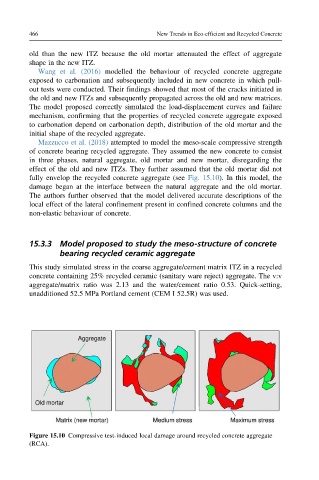Page 518 - New Trends in Eco efficient and Recycled Concrete
P. 518
466 New Trends in Eco-efficient and Recycled Concrete
old than the new ITZ because the old mortar attenuated the effect of aggregate
shape in the new ITZ.
Wang et al. (2016) modelled the behaviour of recycled concrete aggregate
exposed to carbonation and subsequently included in new concrete in which pull-
out tests were conducted. Their findings showed that most of the cracks initiated in
the old and new ITZs and subsequently propagated across the old and new matrices.
The model proposed correctly simulated the load-displacement curves and failure
mechanism, confirming that the properties of recycled concrete aggregate exposed
to carbonation depend on carbonation depth, distribution of the old mortar and the
initial shape of the recycled aggregate.
Mazzucco et al. (2018) attempted to model the meso-scale compressive strength
of concrete bearing recycled aggregate. They assumed the new concrete to consist
in three phases, natural aggregate, old mortar and new mortar, disregarding the
effect of the old and new ITZs. They further assumed that the old mortar did not
fully envelop the recycled concrete aggregate (see Fig. 15.10). In this model, the
damage began at the interface between the natural aggregate and the old mortar.
The authors further observed that the model delivered accurate descriptions of the
local effect of the lateral confinement present in confined concrete columns and the
non-elastic behaviour of concrete.
15.3.3 Model proposed to study the meso-structure of concrete
bearing recycled ceramic aggregate
This study simulated stress in the coarse aggregate/cement matrix ITZ in a recycled
concrete containing 25% recycled ceramic (sanitary ware reject) aggregate. The v:v
aggregate/matrix ratio was 2.13 and the water/cement ratio 0.53. Quick-setting,
unadditioned 52.5 MPa Portland cement (CEM I 52.5R) was used.
Figure 15.10 Compressive test-induced local damage around recycled concrete aggregate
(RCA).

